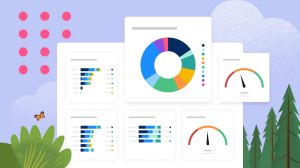What’s better than making a sale? Making a selling machine — a defined sales process fit to match your customer and your product, with tools and data to make your sellers more productive and efficient. Create this, and the repeatable, dependable sales will come. That’s what a sales strategy is all about.
Below we share why a sales strategy matters and how to build one, step by step.
Table of Contents
- What is a sales strategy?
- Why do you need a sales strategy?
- Sales strategy types
- How to build a sales strategy in 5 steps (with examples)
- What are the most important tools to improve your sales strategy?
What is a sales strategy?
A sales strategy sets a path to hit revenue targets by identifying target customers and selling channels, then creating a sales process to match. A sales strategy is never finished. It has to continually adapt to business and market change, always seeking to do more with less. This means that sales leaders have to keep digging into customer and sales performance data to track progress, make adjustments, and stay on course.



Why do you need a sales strategy?
A great sales strategy brings your sellers around common goals, helps them spot risks and trends as they move deals along, and trains them to get better every day. Without a sales strategy, sellers would be out on their own — no shared vision, no shared sales process to know the next best action to take, and no shared data to study and learn what is and isn’t working. Uh-oh: inconsistent sales.
Here are the main reasons why you need a sales strategy:
Clear steps to advance customers through the sales pipeline
A sales strategy creates a blueprint for sellers to know the next step to take: how to handle certain objections, when to reach out with another email, and when to loop other people into the conversation. Think of it as a playbook with repeatable steps and reusable techniques for closing deal after deal.
More productive sellers and faster onboarding
A sales strategy takes all the lessons learned from past wins and failures and distills those lessons into best practices that every seller can benefit from. New sellers and sellers with room to improve can start behaving like your high-performers, with guidance and actions on everything from prospecting leads to closing deals.
Real-time visibility into the sales process to learn and improve
The structure you create in your sales process allows you to bring all of your data into one place and track the same key metrics for every rep. Are sellers performing as expected? Are they selling enough to hit your forecast? Are there red flags showing up in conversations? This baseline understanding of all your data (especially when it’s updated in real-time) helps you coach your reps to perform better.
In the next section, we’ll look at different kinds of sales strategies that can help you level up.
Learn how thousands of sales pros are driving productivity — today.
Read our new State of Sales report and discover tips and tools from sales teams who are maximising value in a time of uncertainty.


Sales strategy types
A sales strategy is based largely on two things: customer type and sales channel.
- Customer type (often called a customer segment) is usually based on size, industry, region, or the product they’re buying.
- Channel is how you reach these customers. For example, you could connect through direct sales, partners, or self-service channels.
While you can build a strategy around one of these — segment or channel — the most effective strategies take both into account. Let’s break it down.
Sales strategies based on customer type
The type of sales strategy you choose begins with how you group your target customers — typically by size, region, product, or industry.
Let’s take a look at each one.
- Segment by company size. These segments commonly break down into enterprise companies versus small and medium-sized businesses. This allows you to split your sellers into two different selling approaches. One targets large companies for a relatively small number of high-value deals, and the other targets small and medium businesses (SMBs) for lower-value, higher-volume deals.
- Segment by region. This approach makes sense as you expand into a global presence because you’ll need to identify the best practices for different local needs, with an emphasis on the unique languages, business pains, and cultural nuances in each place.
- Segment by product. This often makes sense for large companies that have a mix of legacy products and new, smaller ones (often from acquisitions). You’ll want to make sure that the newer, smaller products don’t get lost in the mix. Holding certain sales teams accountable to those products while dedicating other sellers to legacy products will help you shore up success on all sides.
- Segment by industry. This groups sellers around industries like manufacturing, healthcare, and financial services. A sales strategy that serves this customer segment can be a great way to increase win rates (the number of deals you sell), because it trains sellers to develop subject matter expertise that helps them really address the unique pains of different customers, from supply chain woes (as might be the case with manufacturing) to compliance needs (as might be the case with financial services).
Sales strategies based on selling channel
Now that you’ve grouped your customer segment, map the target customer to the right channel based on how they prefer to buy — via direct sales, channel sales, or self-service sales. A company will often begin by focusing on one channel, become great at it, and then build more to create a mix of different revenue streams.
Here are the three main selling channels.
1. Direct sales is classic sales: one rep talking to one customer, building a relationship over time, and finally bringing the deal to close. Choose this for your sales strategy when your product is complex or the deal size is large, requiring a longer sales cycle and a high level of human involvement. Direct sales will often be the sales strategy for enterprise sales (also known as complex sales).
Learn more about how to craft the ultimate enterprise sales strategy
2. Channel sales (also known as partner sales) is a great approach for growing revenue without adding new headcount. It lets you sell through vendors like partners, resellers, and distributors, a move that’s increasingly important as sales teams everywhere are trying to drive down costs.
Read the complete guide to channel sales and sell more without adding costs
3. Self-service sales lets customers buy without talking to a sales rep through channels like online stores. For example, Salesforce lets customers purchase software right through the Salesforce Starter webpage. Consider a self-service sales approach when you want to make it easier and faster for customers to buy. It’s especially powerful for selling subscriptions, since customers can add or make changes to their subscriptions without having to talk to a rep.
Discover the basics of managing a self-service channel for subscriptions
How to build a sales strategy in 5 steps (with examples)
Ready to build a sales strategy? Start by understanding your sales goals and the customers you want to target, and then choose a sales channel to reach them. Finally, build a sales process that you can study, learn from, and improve over time.
Here’s how to begin, one step at a time.
1. Define your sales targets
A sales leader will often begin the year with a target of how much revenue to bring in. This will help determine what customers you need to target and how many deals you need to close in the coming year.
Let’s imagine your target is $1 million in revenue. Now you’ll need to determine the right target customer and selling channel in order to meet your goal.
2. Determine your target customer and selling channel
First, determine your target customer based on how you slice and dice the market and what will likely get you to your revenue goal. As we noted above, you can focus on company size, region, industry, or the product you’re selling.
Second, conduct competitor research and learn more about the customer’s operating methods (online and via sources in your network) to determine how your target customer likes to buy. This will determine the sales channel you focus on.
For example, say you’re selling accounting software to enterprise business customers and you see a big opportunity among financial services firms. You know from experience that these buyers like to buy one-on-one from experts who understand the nuances of their regulatory environment. Ding-ding-ding! Train your sellers to speak the language of this specific industry and move forward with direct sales.
3. Build the most efficient sales process to hit your numbers
At this point, identify the steps your sales team can follow to complete a sale — the sales process — with the type of customer and channel you’ve chosen. Think of it as a roadmap with checkpoints between first customer contact and close, with guidance on how to move from one checkpoint to another.
The stages you choose and the milestones for each one will depend on the customer and channel. Here’s an example of a sales process that might fit our example target customer (financial services) and channel (direct sales):
- Prospect: Find new leads via online sources or your professional network.
- Qualify: Determine whether your product is a good fit for a prospect by calling bank managers.
- Research: Learn more about your prospect via online sources and industry research.
- Pitch: Connect with your prospect again to demonstrate the value of your offering.
- Overcome objections: Answer questions and allay concerns. Consider showing a demo to demonstrate how your product will help.
- Close: Negotiate terms and sign the deal.
- Nurture and continue to sell: Focus on post-sales activities, such as customer adoption and success, renewals, and marketing partnerships like events and referrals.
4. Fill your sales pipeline with enough leads to hit your target
Now that you’ve defined the stages in your sales process, fill your sales pipeline with prospects. Determine how many you need based on likely deal size for the customer types you’re targeting and past conversion rates. Then, use marketing channels and network outreach to connect with them.
In our example, you know you need to hit a $1 million revenue target. If the enterprise tier of your accounting software sells for $10,000 a year, you’ll need to close 100 deals to hit your goal. You know that last year’s conversation rate for enterprise prospects was 30%, which means your team probably needs about 330 prospects in your pipeline.
You also know that many of the decision-makers for big banks attend finance conferences, so you register several of your reps for the major ones in your region to make connections and identify prospects.
Prospects coming in? You’re ready to sell! (Wait, how do I sell? Good question. Read our definitive guide.)
5. Put your sales process to work and improve as you go
As you roll out the rest of your sales strategy, your team will dive into selling, going from cold leads to warm opportunities to red-hot deals. At the same time, your business and your market will experience disruption and change. So it’s critical to continually monitor the health of your pipeline, and if things aren’t going as expected or a change throws a wrench into your selling machine, then act to adjust.
Let’s say many of your prospects are suffering from tightened budgets. Instead of pushing your enterprise software, you pivot from fewer, high-value deals to more mid-value deals. How? You start recommending a lower-cost, midrange tier of your accounting software that can be easily upgraded when the time and budget are right.
Segmenting … channeling … pipelining? There’s a lot to a successful sales strategy. Good thing technology is here to help. Below we share how.
“Companies are moving away from high-risk strategies as they battle inflation, supply chain bottlenecks, regulatory uncertainty, and political disruption. 69% of sales professionals say selling is harder now.* Learn how sales automation can help your business by downloading our free State of Sales Survey results.”
(*according to the State of Sales)
State of Sales Report
Discover the latest insights driving productivity and efficiency for more than 7,700 sales professionals.



Best practices for a sales strategy
As you build your sales strategy and implement it throughout your organisation, there are certain best practices you should incorporate. These include:
1. Update your buyer personas regularly
It’s important for your brand to be proactive and try to update your buyer personas regularly so that your sales and marketing efforts will continue to appeal to your audience. There are a number of reasons to update your buyer personas regularly which include:
- Change in consumer behaviour: Over time the needs and pain points of your buyers will change. Consumer behaviour evolves over time due to various factors such as technological advancements, cultural shifts and economic changes.
- Market segmentation: As markets expand and new customer segments emerge, it becomes necessary to refine and update buyer personas. By identifying and understanding these new segments, you can better tailor your products, services and messaging to effectively reach and engage these audiences.
- Maintaining competitive edge: As competitive landscapes are constantly evolving with new businesses entering the market and existing ones adapting their strategies. Regularly updating buyer personas helps businesses stay informed about their audience. This allows them to continue to meet their needs, preventing loss to competitors.
- Improved personalisation: Personalisation has become increasingly important in today’s business environment. By developing more specific buyer personas, businesses can gather up-to-date information about their customers’ preferences and pain points to create unique experiences for the targeted audience.
- Product development and innovation: Buyer personas provide valuable insights into customer needs and expectations. By updating these personas, businesses can identify new product opportunities or enhance existing offerings to remain relevant for their buyers.
2. Aligns your sales and marketing efforts
A sales strategy helps to clearly communicate the shared goals and objectives that both sales and marketing teams can work towards. By aligning these activities, businesses can create a seamless customer journey which will lead to an increased lead generation, improve customer satisfaction and drive overall business growth.
3. Use technology such as a CRM
Customer relationship management (CRM) is a technology for managing all your company’s relationships and interactions with customers and potential customers throughout your lifecycle with them. A CRM provides automated help as you try to achieve the sales KPIs of your sales strategy. It helps you identify new customers, win their business and provide support and additional services throughout the relationship.
Learn more about Sales Cloud today.
4. Listen to feedback from your prospects
As you move prospects through their sales funnel, you should try to gather their feedback. No matter if they have converted or if they drop off, receiving feedback will help you to identify the strengths and weaknesses of your sales process.
5. Invest in regular development and training for your sales teams
The market is constantly adapting and so should your sales reps. Providing regular training for your team in the latest technology and sales methods will give them the tools to improve and be more effective.
As you update your products, you will also need to provide regular training to maintain your reps’ in-depth knowledge about your company’s products or services. This will enable them to confidently articulate your brand’s value proposition, address customer questions and position the offerings effectively
What are the most important tools to improve your sales strategy?
Building and executing a sales strategy starts with a single source of truth, a CRM, where you can segment your customers and channels and map specific actions to your sales process. Additional tools can be combined with a CRM to boost productivity and efficiency, from reports and dashboards to forecasting tools and revenue management software.
Here are a few of the most important tools to consider:
Customer relationship management (CRM) system
A CRM gives you a complete view of all your prospects and customers. This visibility is critical for tracking your leads from click to close, monitoring what is and isn’t working, and making smarter decisions about where to invest.
Reports and dashboards
Reports and dashboards provide a real-time picture of your business revenue at a glance. This helps sales leaders continually adjust their sales strategy to stay on target, and dig deeper into detailed reports that can show insights at the level of the individual deal or seller.
Pipeline management and sales forecasting
Remember the defined sales process you created earlier in your strategy? Bring in pipeline and forecasting technology to help you stay up to speed on your team’s progress. Get a handle on where every deal sits in the pipeline and roll those numbers up to create accurate sales forecasts. Then, make cost-effective decisions about where to focus your resources.
Revenue management
A revenue management tool can help you connect customer touchpoints — like quoting, selling, and billing — that used to be locked away in different systems. When you connect the flow of customer data from one touchpoint to the next, you can make it easier and faster for customers to buy.
Utilise automation in your sales strategy
Sales automation tools can help field reps get all the information they need to close an account when they use the available mobile apps. For inside sales, teams can use desktop solutions to win over new customers. Sales automation software doesn’t replace sales reps. Instead, sales automation tools help your reps close more deals, faster with functionality including building, automating and delivering custom workflows with Salesforce process automation software.
Many AI sales automation tools integrate with your existing CRM software, too. Salesforce has just launched Einstein GPT, the world’s first generative AI CRM technology, which delivers AI-created content across every sales, service, marketing, commerce, and IT interaction, at hyperscale.
With Einstein GPT, you will have the opportunity to transform how you manage your sales process with generative AI that makes personalising their experience seamless. Learn more about Einstein GPT today.
When in doubt, go back to basics
Creating a sales strategy is like building a car while driving it. You’re asked to hit your numbers while also building the machinery beneath. When in doubt, come back to the basics. According to Tiffani Bova, global growth evangelist at Salesforce, the basics come down to these questions: Who is your customer? What is your product? And how does your customer like to buy? When you can answer these, you know you’re on the right track.
FAQs
Question: What are the 4 sales strategies?
Answer: Salespeople employ four fundamental sales strategies: script-based selling, needs-satisfaction selling, consultative selling, and strategic-partner selling. These strategies can be adapted and applied according to the specific types of relationships they engage in.
Question: What are the 5 P’s of sales?
Answer: The significance of the 5 P’s of marketing cannot be overstated. This framework, comprising Product, Price, Promotion, Place, and People, serves as a valuable compass for marketers, enabling them to develop effective marketing strategies and maintain a clear focus on key aspects. Now, let’s delve deeper into how each element holds importance for your brand.
















